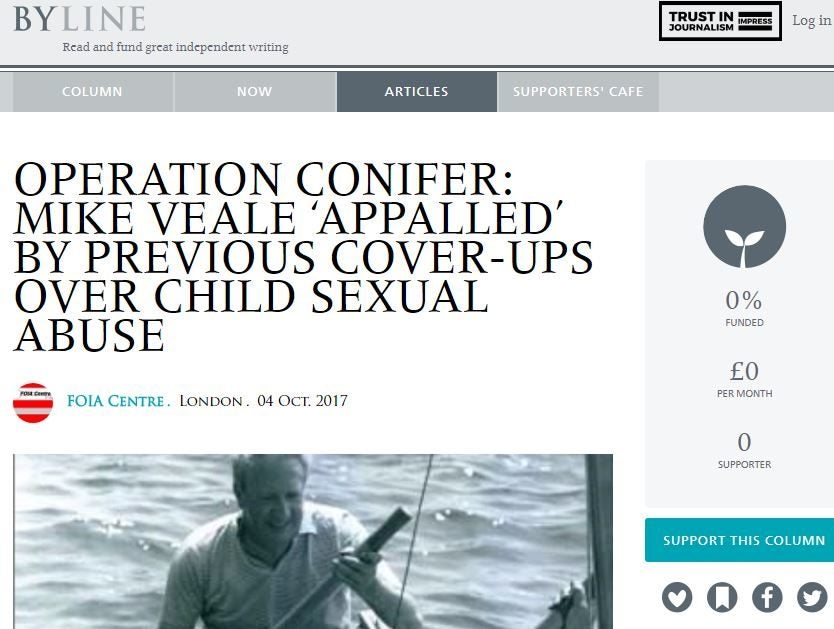
Byline breached accuracy standards in a story about a police investigation into child sex abuse allegations against former Prime Minister Sir Edward Heath, press regulator Impress has ruled.
The article included an interview with Wiltshire Police chief constable Mike Veale who said he was “appalled” by the discoveries of Operation Conifer, his force’s probe into the claims against Heath, along with details of some of the investigation’s findings.
The story was published on 4 October, 2017, with the headline: “Operation Conifer: Mike Veale ‘appalled by previous cover-ups over child sexual abuse,” and is still online at the time of writing.
In one paragraph, the article refers to a picture of Heath in a sailing boat “with what appears to be a teenage boy and an adult male” and directs readers to “a better crop of the picture on the FOIA Centre’s website”.
The FOIA Centre is a research company specialising in stories based on research obtained under Freedom of Information requests. Its co-ordinator is Mark Watts, also author of the Byline story.
Watts is the former editor of Exaro News, where he reported on an alleged paedophile ring involving high-profile public figures that led to a Met police probe into the claims based on an Exaro source.
Watts came in for criticism after the investigation collapsed without making any arrests in March 2016. Exaro closed a few months later in July that year.
In his article on Byline, Watts claimed the picture of Heath “is not thought to have been published before, but is understood to have been taken in Jersey in 1972, while Heath was prime minister”.
He added: “It’s copyright owner is unknown. Anyone with information about the picture is asked to come forward.”
Watts said the picture had been passed to him anonymously and that it had been found in an overseas newspaper archive, captioned as having been taken in Jersey in 1972. He said he had tried to discover the provenance of the photograph via a Google reverse-images search without success.
Shortly after publication, the article was updated to say that readers had provided further information about the picture “which appears to confirm that it was taken in Nice in 1965”.
The update went on to name a friend of Heath’s and his 15-year-old son, who is one of Heath’s godsons, as the other people in the picture.
A complaint was made to the publisher by Simon Just that the article had been inaccurate and misleading. He said that including the photograph in the story implied that Heath had acted inappropriately with the teenage boy pictured. This was rejected by Byline and Watts.
Just escalated his complaint to Impress, which has regulated Byline since September 2016.
He also said that the request for information on the photograph “had been framed to sound as though it was the police who were seeking further information about the image, in connection with Operation Conifer, rather than just the author”.
He said the picture could easily have been found through a Google search and was taken from British Pathe footage of Heath, which was disputed by Watts.
Byline said it was satisfied that the update to the story added “when the proper origin of the photograph was discovered” had been “appropriate”.
Impress said: “By publishing an invitation to readers to click through to a better crop of the picture, alongside inaccurate information about the date and location of the picture, having been unable to verify its provenance and taking account of the sensitive subject matter of the article, the [Complaints] Committee concluded that the publisher had breached accuracy clauses of its standards code by not taking all reasonable steps to ensure accuracy.
“The Impress Standards Code also requires publishers to correct any significant inaccuracy with due prominence at the earliest opportunity. The Impress guidance makes clear that this includes images, which must be accurate representations of the stories they accompany.
“Placing the image and instructions to click through to a better crop of the picture alongside an article about Operation Conifer, and accompanying it with text which implied that it had direct significance to the substance of that investigation, when that was not the case, amounted to a significant inaccuracy.”
This failure to correct the inaccuracy with due prominence in the updated copy also breached accuracy guidelines, Impress said.
The regulator ordered Byline to remove the reference to clicking through for a better crop of the picture and references to it in the article.
It has also ordered Byline to publish a correction with a link to the full adjudication on its homepage for 48 hours and on social media.
Impress said the original article should also include the correction for as long as it continues to be published on the website.
Press reform campaigner Max Mosley is listed in Companies House as one of 11 shareholders in Byline Media Holdings. Impress is almost entirely funded by £3.8m provided indirectly by Max Mosley’s family charity.
Picture: Byline/screenshot
Email pged@pressgazette.co.uk to point out mistakes, provide story tips or send in a letter for publication on our "Letters Page" blog
